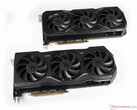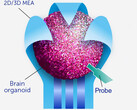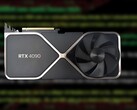In a recent interview with Japanese publication 4gamer, AMD’s senior vice president of engineering for the Radeon Technologies Group David Wang together with executive vice president of computing and graphics Rick Bergman revealed some of the technologies that may be implemented with the introduction of the next gen RDNA 4 GPUs.
One of these technologies is proposed by David Wang and refers to a self-contained GPU pipeline that generates drawing calls exclusively on the graphics processor without the involvement of the CPU. This way, the GPU processing speed can improve considerably, as there would not be any back-and-forth between the system memory with the CPU on one side, and the VRAM with the GPU on the other side. Additionally, the GPU would not need to wait for any commands from the CPU anymore. A 2.2x performance boost over the current RDNA 3 implementation is expected with this new draw pipeline.
AMD also plans to make use of more extensive AI algorithms with the next gen RDNA 4 architecture. The RDNA 3 cards introduced AMD’s first take on AI acceleration cores similar to Nvidia’s Tensor cores, but the performance is still modest comparatively. While RDNA 4 would clearly improve on floating point calculation speeds, Wang is more interested in using this type of inference accelerators for other aspects beyond image processing. AMD already proved that Nvidia’s DLSS can be reproduced without the use of AI in the case of FidelityFX Super Resolution. Moreover, this image supersampling algorithm is open source.
Wang believes that the AI processors in the next gen GPUs should be used to improve the gaming experience as a whole, not just the visual aspect. In this regard, Wang envisions more realistic movements and behaviors for game characters and NPCs. Pathfinding calculations should also benefit from the advanced inference cores. And as far as AI-powered video processing is concerned, Wang thinks the inference cores should not be limited to image fidelity improvements, but could help with more advanced indirect lighting or 3D primitives rendering, adding to the complexity of a scene.
Talking about AMD’s future plans and strategies, Rick Bergman “promises” that the RDNA 4 GPUs will be launched in the near future. Looking at the previous RDNA generations, AMD has maintained a 2-year release cadence, so Bergman’s near future most likely refers to some time in 2024.
Buy the XFX Speedster MERC310 AMD Radeon RX 7900XTX graphics card on Amazon
Source(s)
via Videocardz / Digitaltrends


 Deutsch
Deutsch English
English Español
Español Français
Français Italiano
Italiano Nederlands
Nederlands Polski
Polski Português
Português Русский
Русский Türkçe
Türkçe Svenska
Svenska Chinese
Chinese Magyar
Magyar














